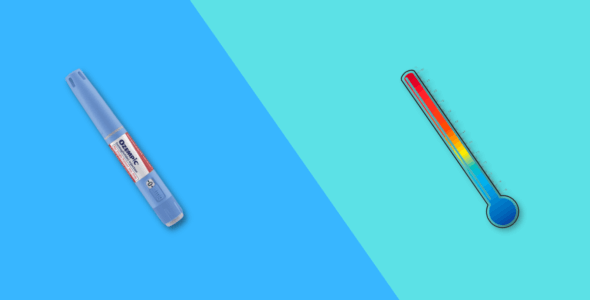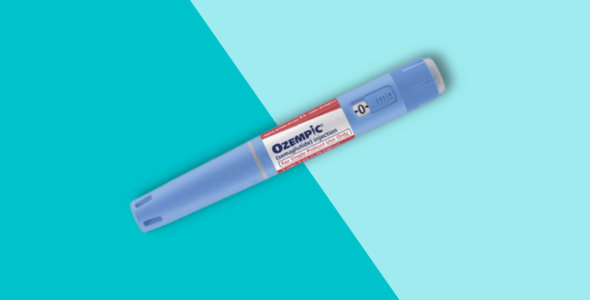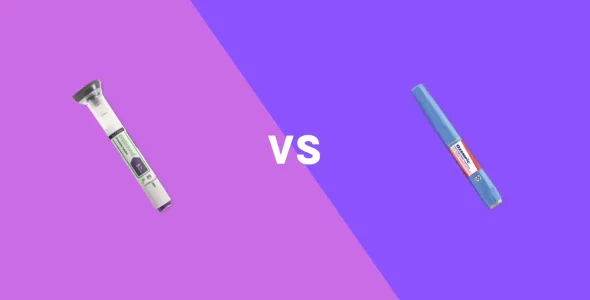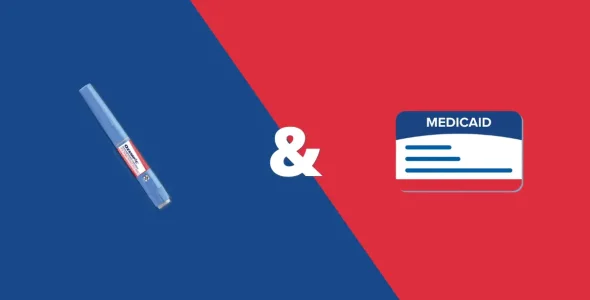Ozempic alternatives: Comprehensive guide (2025)
Considering Ozempic? Explore Ozempic alternatives for more effective weight loss and blood sugar control.
Key highlights
- Ozempic has several alternatives for type 2 diabetes and weight management. The choice of the best Ozempic alternative depends on your health goals and personal preferences.
- Rybelsus, Mounjaro, Trulicity, Victoza, Metformin, Bydureon, and Byetta are possible alternatives to Ozempic for diabetes management.
- For weight management, Wegovy, Zepbound, Saxenda, Qsymia, Contrave, and Xenical are good alternative options.
- Natural alternatives that enhance GLP-1 production, such as Berberine, fiber supplements, apple cider vinegar, a protein-rich diet, and lifestyle modifications, can also promote weight loss and blood sugar control.
- While natural alternatives may provide some benefits, they are not as effective as medications.
- There is currently no generic version of Ozempic available in the United States.
According to the Centers for Disease Control and Prevention (CDC), 38 million U.S. residents (about 1 in 10) have diabetes, and 90-95% of them have type 2 diabetes. These alarmingly high rates of diabetes emphasize the need for anti-hyperglycemic medications, including semaglutide (Ozempic). The FDA has approved the medication for type 2 diabetes management, but its high cost and occasional unavailability in the market are major concerns for most patients. This is where Ozempic alternatives play a critical role.
Ozempic is a weekly injection with semaglutide as an active ingredient, which acts as a GLP-1 receptor agonist. GLP-1 agonists mimic the action of a natural hormone called glucagon-like peptide-1 in the body. This hormone regulates appetite and controls blood sugar levels in the body. The active ingredient of Ozempic, semaglutide, has 94% structural similarity to the human GLP-1 hormone. Ozempic is FDA-approved for type 2 diabetes, cardiovascular risk reduction, and to reduce the risk of worsening kidney disease in patients with chronic kidney disease and type 2 diabetes. The medication is also used off-label for weight management.
The list price of Ozempic is $997.58 per 28-day supply, and the average retail price at pharmacies is $1,000-1,300. The high cost can be challenging for some patients. Higher costs, unavailability of Ozempic in the market, and gastrointestinal side effects are some of the major challenges with Ozempic usage.
This article provides a comprehensive overview of effective and safe alternatives to Ozempic. We will discuss different types of Ozempic alternatives, such as GLP-1 agonists, dual agonists, orals, non-GLP-1 medications, and lifestyle approaches.
Ozempic alternatives for type 2 diabetes
Rybelsus, Mounjaro, Trulicity, Byetta, Metformin, Victoza, and Bydureon BCise are alternative type 2 diabetes drugs to consider.
Rybelsus (semaglutide)
Like Ozempic, Rybelsus is a brand-name drug and contains semaglutide, but it comes in the form of oral tablets that are taken daily. Ozempic is an injectable medication which is administered once weekly. Rybelsus is FDA-approved for lowering blood sugar levels in patients with type 2 diabetes when used as an adjunct to dietary modifications (low-calorie diet) and increased physical activity. Ozempic is also approved for type 2 diabetes but it also provides cardiovascular benefits that Rybelsus does not. Rybelsus has not been approved to provide the same blood glucose benefits as Ozempic for type 2 diabetics.
Both medications reduce HbA1c levels (glycated hemoglobin, a key marker for blood sugar control in people with type 2 diabetes) and maintain blood sugar levels. However, Ozempic is more effective in promoting blood sugar control and lowering HbA1c than Rybelsus.
Available doses of Rybelsus are: 3 mg, 7 mg, and 14 mg.
According to clinical studies, Ozempic can reduce levels of glycated hemoglobin (HbA1c) by about 1% to 1.5%, while Rybelsus typically reduces it by 0.8% to 1%. The difference may be due to variations in administration methods and dosages. Ozempic is injected once a week and provides more consistent blood sugar control than daily tablets of Rybelsus.
The wholesale acquisition cost (WAC) or list price for Rybelsus (3 mg pack, 7 mg pack, and 14 mg pack) is $997.58 per package (30 tablets). You can get the medication for $1,000 to $1,300 or more. Both medications have approximately the same prices, but Rybelsus can be suitable for those who are afraid of injectables and prefer oral tablets over injections.
Mounjaro (tirzepatide)
Mounjaro has tirzepatide as an active ingredient, which is a dual glucose-dependent insulinotropic polypeptide (GIP) receptor and glucagon-like peptide-1 (GLP-1) receptor agonist medication. The medication has a similar mechanism of action to semaglutide, but semaglutide activates only GLP-1 receptors, while tirzepatide activates both GIP and GLP-1 receptors. The medication can be a safe alternative to Ozempic in reducing blood sugar levels in type 2 diabetes and managing weight when used as an adjunct to exercise and dietary changes.
Like Ozempic, Mounjaro is also injected subcutaneously once a week. The medication can be used alone or in combination with other FDA-approved anti-diabetes medications (such as sulfonylureas, metformin, insulin, and sodium-glucose co-transporter 2 inhibitors).
Pre-filled injections of Monjaro are available in these doses: 2.5 mg, 5 mg, 7.5 mg, 10 mg, 12.5 mg, 15 mg.
A clinical study compared the effectiveness of tirzepatide (Mounjaro) and semaglutide (Ozempic) in lowering glycated hemoglobin levels. Tirzepatide reduced HbA1c by -2.01%, -2.24%, and -2.30% with 5 mg, 10 mg, and 15 mg, respectively. In comparison, 1 mg semaglutide reduced HbA1c by -1.86% after 48 weeks. The study projects that tirzepatide provides a greater reduction in HbA1c compared to semaglutide. However, tirzepatide is not FDA-approved to provide the same cardiovascular benefits in patients with heart disease and chronic kidney disease as Ozempic.
The list price of Mounjaro is $1,079.77 per fill. However, pharmacies might sell the medication for $1,100 to $1,300 or more.
Trulicity (dulaglutide)
Trulicity (dulaglutide) is an injectable GLP-1 agonist that is FDA-approved for improving blood sugar control in adults with type 2 diabetes and reducing the risk of cardiovascular events (such as heart attack and stroke) in type 2 diabetes patients with established heart disease or multiple cardiovascular risk factors. Some people may also experience weight loss with this medication.
Trulicity has the same mechanism of action as Ozempic. The medication occupies GLP-1 receptors to promote insulin release, reduce sugar production, and slow down digestion (gastric emptying), which contributes to better glycemic control and often significant weight loss.
Like Ozempic, Trulicity also has proven cardiovascular benefits. The SUSTAIN 7 trial was conducted to compare the effectiveness of once-weekly semaglutide (0.5 mg or 1 mg) with once-weekly dulaglutide (0.75 mg or 1.5 mg) in patients with type 2 diabetes after 40 weeks. Semaglutide showed superior results in lowering HbA1c (1.8% vs. 1.4%) and body weight (10-14 lbs vs. 5-7 lbs) compared to dulaglutide.
The list price of Trulicity is $987.19 per month. The retail price may range from $1,000 to $1,300.
Victoza (liraglutide)
Victoza has liraglutide as an active ingredient. Liraglutide belongs to a drug class called GLP-1 (glucagon-like peptide-1) receptor agonists. It has a similar mechanism of action to Ozempic. Victoza is FDA-approved to control blood sugar in type 2 diabetes patients (adults and children aged 10 years or older) as an adjunct to dietary modifications and exercise.
Victoza comes in the form of a 6 mg/ml injection solution in a pre-filled, single-patient-use pen that delivers doses of 0.6 mg, 1.2 mg, or 1.8 mg.
A SUSTAIN 10 clinical trial involved 577 adults with type 2 diabetes to compare the effectiveness of semaglutide (1 mg once weekly) and liraglutide (1.2 mg once daily) in lowering blood sugar levels and body weight over 30 weeks.
In semaglutide users, mean HbA1c decreased by 1.7%, and the liraglutide group showed a decrease in HbA1c by 1.0%. Mean body weight (baseline 96.9kg) decreased by 5.8 kg in semaglutide users and 1.9 kg in liraglutide users. The results show that semaglutide (Ozempic) is superior to liraglutide in lowering glycated hemoglobin levels and body weight. However, liraglutide has fewer side effects than semaglutide. If you cannot tolerate the side effects of Ozempic, Victoza can be a good choice.
The list price of Victoza is $543.51 for a 28-day supply. The average retail price is $795.66 per month. The medication is cheaper than Ozempic.
Metformin
Metformin belongs to a class of biguanides that come in the form of immediate-release and extended-release tablets. The medication decreases glucose production in the liver and absorption of glucose in the intestines and increases insulin sensitivity. This way, it promotes blood sugar control in patients with type 2 diabetes.
The immediate-release tablets are usually taken with meals once or twice a day. The extended-release tablet is usually taken once a day with the evening meal.
Metformin tablets are available in four strengths: 500 mg, 625 mg, 750 mg, 850 mg and 1000 mg.
The average list price of metformin is $22.33, which is significantly lower than the price of semaglutide.
Bydureon BCise (exenatide)
Bydureon is an FDA-approved medication with exenatide as an active ingredient. Bydureon is indicated for lowering blood sugar levels in diabetes. The medication can also be used for the treatment of Parkinson’s and weight management.
Exenatide, the active ingredient of Bydureon, is a GLP-1 receptor agonist. It mimics the action of the incretin hormone, glucagon-like-peptide-1 (GLP-1), and promotes insulin release, delays gastric emptying, suppresses glucagon secretion, and decreases food intake. These actions enable exenatide to promote blood sugar control in diabetes.
Bydureon comes in extended-release injectable suspension in the form of:
- Single-dose vials (2 mg)
- Single-dose pens (containing 2 mg of exenatide)
A clinical trial involved 813 people with type 2 diabetes to compare the effectiveness of semaglutide and exenatide in type 2 diabetes patients. The participants randomly received either semaglutide 1.0 mg or exenatide ER 2.0 mg for 56 weeks. The study found that semaglutide was more effective in lowering HbA1c levels, reducing it by 1.5%, compared to 0.9% with exenatide ER. Semaglutide also led to a greater weight loss of 5.6 kg, while exenatide ER caused a weight loss of 1.9 kg.
In the same study, more semaglutide users (67%) achieved a reduction in HbA1c (below 7.0%) compared to those using exenatide ER (40%). Both treatments had similar safety profiles, though gastrointestinal side effects were more common with semaglutide, while exenatide ER caused more injection site reactions. These findings suggest that semaglutide is a more effective treatment for people with type 2 diabetes who are not well-controlled with oral medications.
Byetta (exenatide)
Byetta is a brand-name drug with the active ingredient exenatide and has a similar mechanism of action to Ozempic. The medication acts as a GLP-1 receptor agonist to manage blood sugar levels in diabetics.
Byetta is injected (subcutaneously) twice a day. It comes in two strengths: 5 mcg and 10 mcg. In comparison, Ozempic is injected once weekly. Byetta has fewer side effects than Ozempic, and it might be suitable for those who cannot tolerate the side effects of Ozempic.
The average retail price for Byetta is $991.08 for a 10 mcg pen.
Ozempic alternatives for diabetes compared
| Brand Name | Drug Class | Dosage Form and Strengths | Price | FDA-Approved Use | Additional Health Benefits | Blood Sugar Control in Clinical Trials Compared to Ozempic (semaglutide) |
|---|---|---|---|---|---|---|
| Rybelsus | GLP-1 Agonist (Semaglutide) | Oral tablets: 3 mg, 7 mg, 14 mg | $997.58 (30 tablets) | Type 2 diabetes (as adjunct to diet and exercise) | Not approved for cardiovascular benefits like Ozempic | In clinical trials, Rybelsus reduced HbA1c by 0.8% to 1%, compared to 1% to 1.5% with Ozempic. |
| Mounjaro | GLP-1 & GIP Agonist (Tirzepatide) | Injectable: 2.5 mg, 5 mg, 7.5 mg, 10 mg, 12.5 mg, 15 mg | $1,079.77 per fill | Type 2 diabetes (with diet and exercise) | May contribute to weight loss, No cardiovascular benefits like Ozempic | Mounjaro significantly outperforms Ozempic in clinical trials, with HbA1c reduction of 2.01% to 2.30% compared to -1.86% for Ozempic. |
| Trulicity | GLP-1 Agonist (Dulaglutide) | Injectable: 0.75 mg, 1.5 mg | $987.19 per month | Type 2 diabetes, cardiovascular risk reduction | Cardiovascular benefits (heart disease prevention) | Trulicity reduced HbA1c by 1.4% in clinical trials compared to 1.8% with Ozempic. |
| Victoza | GLP-1 Agonist (Liraglutide) | Injectable: 0.6 mg, 1.2 mg, 1.8 mg | $543.51 (28-day) | Type 2 diabetes (as adjunct to diet and exercise) | Cardiovascular benefits, weight loss | Victoza reduced HbA1c by 1%, which is less effective than Ozempic, which reduced HbA1c by 1.7%. |
| Metformin | Biguanide | Oral tablets: 500 mg, 625 mg, 750 mg, 850 mg, 1000 mg | $22.33 (per bottle) | Type 2 diabetes (as adjunct to diet and exercise) | Weight loss, cardiovascular risk reduction, improvement in lipid profile | 1.12% after 12 weeks of using metformin |
| Bydureon | GLP-1 Agonist (Exenatide) | Injectable: 2 mg (single-dose vials or pens) | $978.82 | Type 2 diabetes | Weight loss, Parkinson’s treatment | Bydureon reduced HbA1c by 0.9% and Ozempic reduced HbA1c by 0.9%. |
| Byetta | GLP-1 Agonist (Exenatide) | Injectable: 5 mcg, 10 mcg (twice daily) | $500.00 (28-day) | Type 2 diabetes (as adjunct to diet and exercise) | Weight loss, lower cardiovascular risks | 1.7% reduction in HbA1c after 6 months |
Ozempic alternatives for weight loss
The following weight loss drugs can be considered Ozempic alternatives:
Wegovy (semaglutide)
Wegovy has the same active ingredient, semaglutide, as Ozempic, which mimics the action of the GLP-1 hormone. Wegovy is an FDA-approved weekly injection for chronic weight management in adults with obesity or overweight with at least one weight-related condition, and cardiovascular risk reduction (to reduce the risk of heart attack or MI, stroke, or death) in adults with established cardiovascular disease.
Wegovy has been studied for weight management in people with and without type 2 diabetes. A clinical trial compared the effectiveness of semaglutide with different doses. Participants who took 2.4 mg of semaglutide (the highest dose of Wegovy) showed more weight loss than those taking 1 mg of semaglutide (a maintenance dose of Ozempic). The results suggest that Wegovy requires a higher maintenance dose for maximum effectiveness and may be more effective in weight reduction given its higher strength.
The list price of Wegovy is $1,349.02 per month from the manufacturer, Novo Nordisk. You may be able to get the medication for $1,300-$1,600 or more from pharmacies. If you have commercial insurance that covers Wegovy and your out-of-pocket expenses are less than $849, you can get Wegovy for $0 with the Wegovy Savings Card. If you are uninsured, you can still get the medication for $499 per month.
Zepbound (tirzepatide)
Zepbound contains the active ingredient tirzepatide which acts as a dual GLP-1 and GIP receptor agonist to suppress appetite, reduce body weight, and manage blood sugar levels. Zepbound is FDA-approved for chronic weight management in patients with obesity and overweight with at least one weight-related health condition, when paired with exercise and a low-calorie diet.
Eli Lilly, the manufacturer of Zepbound, conducted a SARMOUNT 5 clinical trial to compare the effectiveness of semaglutide and tirzepatide in weight reduction. The tirzepatide group lost more weight (47%) than the semaglutide group. On average, people using tirzepatide lost 20.2% of body weight, while semaglutide users lost 13.7% of body weight after 72 weeks. The results show that tirzepatide (Zepbound) outperforms semaglutide (Ozempic) in weight reduction.
Zepbound’s list price is $1,086.37 per fill (28-day supply). You can get the medication from retail pharmacies for $1,000 to $1,300 or more without insurance. Zepbound single-dose vials significantly reduce the price of medication.
Saxenda (liraglutide)
Saxenda has liraglutide as an active ingredient. Liraglutide is a GLP-1 receptor agonist with a similar mechanism of action to Ozempic. Saxenda is an FDA-approved medication for chronic weight management in obese (BMI 30 or more) and overweight patients (BMI 27 or more) with at least one weight-related health condition, when used alongside a reduced-calorie diet and increased physical activity.
The step 8 clinical trial involving 338 individuals compared the efficacy of semaglutide (weekly) and liraglutide (daily) for weight reduction in obese and overweight patients without type 2 diabetes. Participants in the study who used semaglutide showed a mean weight change of 15.8%, compared to a 6.4% weight loss in those using liraglutide. The results show that semaglutide outperformed liraglutide in weight management. Gastrointestinal adverse events were more common in the semaglutide group (84.1%) than in the liraglutide group (82.7%). If you can not tolerate the side effects of Ozempic, Saxenda can be a good alternative.
Saxenda has a list price of $1,349.02. However, with the Saxenda savings card, you can get the medication for $30 or less per month if you meet eligibility criteria.
Qsymia (phentermine/topiramate)
Qsymia is a unique combination of phentermine (FDA-approved for weight management) and topiramate. The medication is typically used for short-term weight management. The FDA has not approved topiramate for weight loss and it’s used off-label for weight loss.
A clinical study evaluated the effectiveness of Qsymia for weight loss. Patients taking Qsymia lost 8% to 10% of body weight after 56 weeks (or 13 months). About 70% of participants lost at least 5% of their initial body weight after 1 year with the highest dose of Qsymia. In comparison, Semaglutide (Ozempic) showed a 15% weight reduction after 68 weeks. Although Ozempic is superior to Qsymia in weight management, Qsymia is generally more affordable than Ozempic. It can be an alternative to Ozempic for those who cannot afford it.
Qsymia extended-release capsules are available in four strengths: 3.75 mg/23 mg, 7.5 mg/46 mg, 11.25 mg/69 mg, and 15 mg/92 mg.
The average retail price for Qsymia is $275 for a 30-day supply, according to SingleCare.
Contrave (naltrexone/bupropion)
Contrave is a combination of naltrexone and bupropion. The medication affects the reward center of your brain to suppress appetite and reduce food intake. In a clinical study, Contrave reduced about 8% of body weight in participants after 56 weeks and 11% with strict lifestyle changes. The medication can be an alternative to Ozempic for weight management.
Contrave is available in single-strength extended-release tablets (8 mg/90 mg) that contain 8 mg naltrexone and 90 mg bupropion.
According to GoodRx, the average retail price of Contrave is $747.39. It may cost less with insurance coverage.
Xenical (orlistat)
Xenical (orlistat) reduces fat absorption (approximately 30%) to promote weight loss. The medication is taken three times a day for weight reduction, along with lifestyle modifications such as a reduced-calorie diet and increased physical activity. In comparison, Ozempic injections are administered once weekly. If you prefer oral medication over injectables, orlistat can be a good choice.
Xenical is available in capsule form (60 mg and 120 mg).
According to SingleCare, the average retail price for orlistat is $889.62 per 90 capsules (120 mg).
Compounded semaglutide
Compounded semaglutide is a tailor-made medication prepared in a compounding pharmacy by a licensed pharmacist, healthcare provider, or people working under the direct supervision of licensed pharmacists. Semaglutide is compounded to meet unique patient needs, such as allergies to certain ingredients of Ozempic or when the patient needs a custom dose or formulation that isn’t commercially available. The medication also fulfils the demand for Ozempic during drug shortages. The FDA does review compounded medications for safety and effectiveness.
Compounded semaglutide is available in the form of oral tablets, orally disintegrating tablets, nasal sprays, injections, and sublingual drops.
Personalized compounded semaglutide is available for $200-300 per month.
Ozempic alternatives for weight loss compared
| Brand Name | Drug Class | Dosage Form and Strengths | Price | FDA-Approved Use | Percentage Weight Loss in Clinical Trials (and Duration) |
|---|---|---|---|---|---|
| Wegovy | GLP-1 Agonist (Semaglutide) | Injection: 0.25 mg per 0.5 milliliters (mL) of solution (0.25 mg/0.5 mL) 0.5 mg/0.5 mL. 1 mg/0.5 mL. 1.7 mg/0.75 mL. 2.4 mg/0.75 mL. | $1,349.02 per month | Chronic weight management in obesity, cardiovascular risk reduction | 15% body weight reduction after 72 weeks. Wegovy provides more effective weight reduction compared to Ozempic (semaglutide). |
| Zepbound | GLP-1 & GIP Agonist (Tirzepatide) | Injection: 2.5 mg, 5 mg, 7.5 mg, 10 mg, 12.5 mg, 15 mg | $1,086.37 per fill | Chronic weight management for obesity and overweight with at least one weight-related condition | 20.2% body weight reduction after 72 weeks compared to 13.7% with Ozempic. |
| Saxenda | GLP-1 Agonist (Liraglutide) | Injection: 0.6 mg, 1.2 mg, 1.8 mg | $1,349.02 per month | Chronic weight management in obesity, overweight with at least one weight-related condition | 6.4% body weight reduction with daily dose of Saxenda comapred to 15% with weekly semaglutide in Step 8 clinical trials |
| Qsymia | Phentermine/Topiramate | Oral capsules: 3.75 mg/23 mg, 7.5 mg/46 mg, 11.25 mg/69 mg, 15 mg/92 mg | $275 (30-day supply) | chronic weight management in adjunct to lifestyle changes | Weight loss: 8% to 10% in 56 weeks, less effective than Ozempic which had 15% weight loss. |
| Contrave | Naltrexone/Bupropion | Oral tablets: 8 mg/90 mg | $747.39 per month | Weight management in adults with obesity and overwight with at least one weight related health condition | 8-10% weight reduction after 56 weeks and 11% with strict lifestyle changes |
| Xenical | Lipase Inhibitor (Orlistat) | Oral capsules: 60 mg, 120 mg | $889.62 per 90 capsules (120 mg) | Weight management in adults with obesity and overweight with at least one weight related health condition | 8.8% weight loss with 120 mg Orlistat compared to 5.8% with placebo after one year. |
Why consider Ozempic alternatives?
You can consider Ozempic alternatives due to the following reasons:
Shortages
The U.S. Food and Drug Administration (FDA) added Ozempic to the drug shortage list in early 2022. Since then, the medication has not been available. In February 2025, the FDA removed the medication from the shortage list. Ozempic alternatives are helpful during these shortages.
Side effects
If you experience severe gastrointestinal side effects such as vomiting, severe stomach ache, diarrhea, constipation, bitter taste, and burping with Ozempic, and these side effects are intolerable, switching to Ozempic alternatives is a good option.
Cost and insurance coverage
If you are unable to get insurance coverage for Ozempic, you can check Ozempic alternatives that are covered by your insurance plans. Ozempic is used off-label for weight loss, and most insurance companies do not cover medication for its off-label usage. Choose FDA-approved medications for weight loss to improve your chances of obtaining insurance coverage.
More effective weight loss
FDA-approved medications for weight loss, such as Zepbound (tirzepatide), and Wegovy (semaglutide), are more effective for weight loss. You can consider these other weight loss drugs instead of relying on Ozempic for its off-label use.
Improved blood sugar control
Certain medications, such as tirzepatide, have a higher efficacy than Ozempic in improving blood sugar control. Discuss with your healthcare professional about switching to tirzepatide from semaglutide for better glycemic control.
Important considerations when choosing an Ozempic alternative
When choosing Ozempic alternatives, keep the following considerations in mind:
- If you are a diabetic, prioritize blood sugar control over other benefits. Choose medications such as Mounjaro, which have higher efficacy in managing blood sugar levels.
- If you have concerns about your budget, consider metformin or older GLP-1 medications, which are often more affordable than Ozempic.
- Tirzepatide (Zepbound) is the best choice if you are using the medication solely for weight management. The medication is FDA-approved for weight management in adults and obese patients with weight-related problems and has a higher efficacy than others. Speak to your doctor about switching from Ozempic to Zepbound.
- Discuss your specific health goals, such as weight loss, blood sugar control, and cardiovascular risk reduction, with your healthcare provider so they can help you make the right decision.
- Inform your doctor about your previous medical history and any other health conditions you may have.
- Discuss the potential side effects of different medications with your doctor.
- Insurance companies have different policies for GLP-1 medications. Evaluate the costs of each medication and verify with your insurance provider about insurance coverage.
- Consider your preferred method of administration, whether you prefer injectables or oral medications.
- Discuss any personal preferences or concerns with your doctor.
- Do not switch medications or start new treatments on your own without consulting a healthcare provider, as weight loss medications are associated with certain risks. Your doctor will perform a detailed assessment of your medical history to ensure the medication is right for you.
How to switch from Ozempic to an alternative medication
Consult your healthcare provider if you plan to switch from Ozempic to another medication. Do not try to change medications on your own because each medication has different doses and strengths which need to be carefully adjusted by a physician. Your healthcare provider will evaluate your current treatment plan and customize a new treatment plan to switch the medications safely. Switching medication without seeking medical advice can result in adverse effects.
Emerging alternatives (2025 update)
Retatrutide is emerging as a peptide-based weight loss medication that acts as a triple agonist at glucagon-like peptide-1 receptors (GLP-1), glucose-dependent insulinotropic hormone receptors (GIP), and glucagon receptors (GCG). The medication is in phase III clinical trials and is expected to be commercially available by 2026 or 2027. Retatrutide is expected to be a blockbuster weight loss medication due to its higher efficiency than current GLP-1 medications. The medication activates three receptors simultaneously, which promotes insulin release, enhances fat breakdown, reduces hunger cravings, suppresses appetite, and maintains blood sugar levels.
Natural alternatives
The following are a few natural alternatives to Ozempic:
- Berberine: Berberine is also called Nature’s Ozempic or natural Ozempic purple pill. Clinical studies show that berberine helps treat metabolic syndrome, enhances insulin sensitivity, decreases waist circumference and reduces cholesterol and triglyceride levels in the blood.
- Fiber supplements: Glucomanna, derived from the roots of elephant yam, can be effective for weight loss. It is very low in calories. When taken properly, Glucomannan suppresses appetite, reduces hunger cravings, and delays stomach emptying. PGX is another fiber supplement that promotes the feeling of satiety and can be useful in weight reduction when used in combination with a low-calorie diet and increased physical activity.
- Apple cider vinegar: A research study published in BMJ Nutrition, Prevention, and Health shows that apple cider vinegar reduces body weight, waist circumference, and body mass index (BMI), promotes blood sugar control and improves lipid profile (levels of triglyceride and cholesterol).
- Protein-heavy diets: Healthy fats (such as avocado oil, olive oil, and flaxseed oil) and lean proteins (like fish, white poultry chicken, cottage cheese, tofu, soybeans, eggs, and lean beef) naturally boost the GLP-1 hormone in the body, which suppresses appetite and promotes blood sugar control.
- Lifestyle modification: Certain lifestyle modifications, intermittent fasting, keto diet, and plate method, adequate sleep, exercise, and increased physical activity, can be helpful in managing weight and blood sugar levels.
These natural alternatives may be helpful, but they are not as effective as GLP-1 drugs.
Frequently asked questions
What’s the cheapest Ozempic alternative?
Metformin is the cheapest alternative to Ozempic. You can get the medication for $20-30 per month. Generic liraglutide is also a good option, with potential weight loss of 5-10% of body weight.
There is currently no generic Ozempic available in the United States.
Are compounded semaglutide and Ozempic the same?
Compounded semaglutide and Ozempic are not the same. Compounded semaglutide is not approved by the FDA. In comparison, Ozempic is an FDA-approved medication; its efficacy and safety have been studied, and it has undergone rigorous testing and reviews before its approval. Compounded semaglutide has not been tested for its safety and effectiveness. The compounded medication is prepared in compounding pharmacies and is an alternative for patients who need custom dosing or formulations that are not commercially available.
Can I switch from Ozempic to Mounjaro?
Yes, you can switch from Ozempic to Mounjaro. Consult your healthcare provider before switching to a new medication. They will evaluate your current dosage before making the switch and then adjust the correct dosage for you.
Bottom line
While Ozempic is an effective medication for type 2 diabetes and weight management, several alternatives are available which may be more suitable for you depending on your personal health goals and needs. If you cannot afford Ozempic due to its high cost, experience severe side effects with Ozempic, or when Ozempic is unavailable during drug shortages, you can choose any of its alternatives to manage diabetes and chronic weight.
For type 2 diabetes management, Rybelsus, Mounjaro, Trulicity, Victoza, metformin, Bydureon, and Byetta are good alternatives to Ozempic.
Wegovy, Zepbound, Saxenda, Qsymia, Contrave, and Xenical can be used as an alternative to Ozempic for weight management.
Natural alternatives include Berberine, fiber supplements, apple cider vinegar, a protein-rich diet, and lifestyle modifications that enhance the GLP-1 hormone in the body naturally.
The choice of the “best” alternative depends on individual needs and circumstances. Consult with your healthcare provider to determine the most appropriate and safe treatment plan for you.












